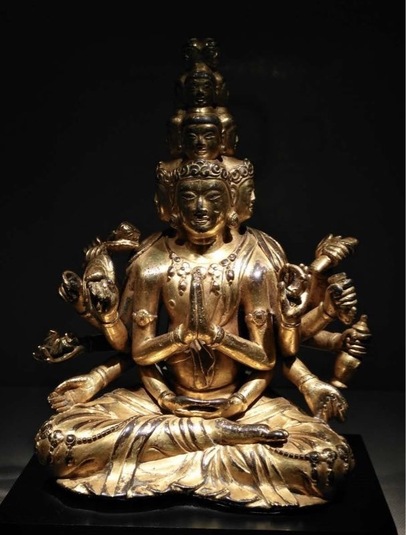
Item: Avalokiteshvara (Bodhisattva & Buddhist Deity) - (11 Faces)
| Origin Location | China |
|---|---|
| Date Range | 1200 - 1299 |
| Lineages | Buddhist |
| Material | Metal, Mercuric Gild |
| Collection | Private |
Alternate Names: Lokeshvara Avalokita Lokanata Lokanatha Mahakarunika
Classification: Deity
Appearance: Peaceful
Gender: Male
Eleven Faced Avalokiteshvara, Dali Kingdom, 10th-13th Century.
The Eleven-Faced Avalokiteshvara, with fourteen arms, and two legs is seated in a relaxed posture. The eleven heads are stacked in four tiers. The eyes have pronounced lids, top and bottom. In the hands are held various symbolic attributes or perform traditional hand gestures. The principal pair of hands are in front held at the heart in the gesture of reverence. The crowns, earrings, necklace and other jewellery are quietly understated.
Based on the style of the sculpture it appears to have originated in the Dali Kingdom (937-1253). The figure has specific facial features and characteristics that are associated with other Dali sculptural works: broad face, wide nose and mouth, and elongated torso. These are some of the characteristics of the Dali sculptural tradition, representing a distinct regional style in response of its specific culture context. The Dali Kingdom was a Buddhist enclave during the Yuan Period. Dali Buddhist iconography has its own specific pantheon and religious context that differs with both China and Tibet. The the cult of Avalokiteshvara and Mahakala were particularly important and unique to the region.
P.C. 6-2018
Region: Dali Kingdom Style Art Main Page
Buddhist Deity: Avalokiteshvara (Eleven Faces)
Collection of Zhiguan (Sculpture)
Region: Dali Kingdom (Peaceful Figures)
Publication: The Art of Buddhist Sculpture (Seer)
Collection of Zhiguan Museum of Fine Art
